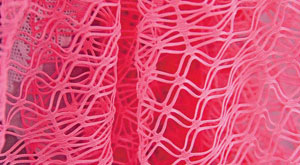
The charm of transparency, fabrics for the future
According to the "Moods Spring-Summer 2015" cards published by the Deutsches-Mode Institut, DMI (German Fashion Institute), ultra-lightweight textiles are the latest trend in both the sportswear and haute couture sectors.
The new open tulle grounds produced on the HKS 3-M and similar warp-knitted fabrics are totally in keeping with the lightness trend.
According to the "Moods Spring-Summer 2015" cards published by the Deutsches-Mode Institut, DMI (German Fashion Institute), ultra-lightweight textiles are the latest trend in both the sportswear and haute couture sectors. They flow beautifully, are light as a feather, and gently envelop the body in fabrics that are as fine as a spiders web. They provide protection and comfort and bewitch the wearer with their ethereal beauty. These lightweight fabrics are frequently translucent. When draped to create attractive dense and transparent effects, these slightly transparent fabrics hint at, rather than actually show, what is underneath. This ethereal, tonal look is produced by combining natural and synthetic fibres, such as linen and polyamide.
Alongside these naturally lightweight textiles are those that set the tone by appearing to radiate lightness. An illusion of lightness is created by using colour effects or pliss̩ constructions, placing opaque pattern elements onto a transparent ground Рusing an embroidery technique, for example Рcombining open effects with compact effects, and using design elements to create a metallic look. Coatings are a vital element in creating these special effects. Applying gold to fine polyester fabrics in particular creates airy, shimmering effects Рoptical elements that are enhanced by their association with gold being a rigid material. The excellent draping characteristics are retained by using special finishing techniques.
The coating is based on nano technology to ensure that the finishing process does not increase the weight. Fine, transparent textiles may be printed. Large-repeat, cut designs create an airy appearance on fabrics with dense, closed surfaces.
Lightweight organza is also right on trend. These shimmering, transparent fabrics can be combined with satin and can also be given a luxurious, mother-of-pearl sheen by a coating process. They may be made from silk, polyester or materials similar to polyester, linen, fine cotton yarns or polyamide. Fine as well as chunky net constructions and waffle-like relief patterns are also important elements in the lightness trend. These design elements also create a sporty look for everyday wear.
Warp-knitted textiles bring a touch of lightness to the designs
Warp-knitted textiles offer a wide variety of design possibilities for creating actual and optical ethereal effects. For example, the FL 20/16 and ML 46 lace raschel machines can produce delicate, all-over lace fabrics with an embroidered look, whilst open, decorative net fabrics can also be produced on the RSJ 4/1 (Fig. 1). One of the big advantages of warp knitting is that it can also be used to produce a wide range of slip-resistant embroidery grounds efficiently. The powernet fabrics produced on the RSE 4-1, for example, have become firm favourites. The light and airy fabrics produced on this raschel machine feature regular mesh structures with circular openings, and may also have extremely fine stitch densities. The tulle and fillet constructions produced on the HKS 2, HKS 2-3 and HKS 3-M are also widely used on the market for embroidery grounds. In addition to their excellent dimensional and structural stability, the textiles produced on these two- and three-bar high-speed warp-knitting machines also feature a regular construction and are therefore ideal for the high-precision production of embroidery patterns efficiently. A wide range of different designs can also be worked in the semi-transparent grounds. For example, the HKS 3-M can be used to produce a variety of marquisette designs – such as fillet fabrics with larger openings – innovative fillet-tulle constructions (Fig. 2) – which are also known as Ice-Net fabrics – and, more recently, 3-stitch hexagonal tul



